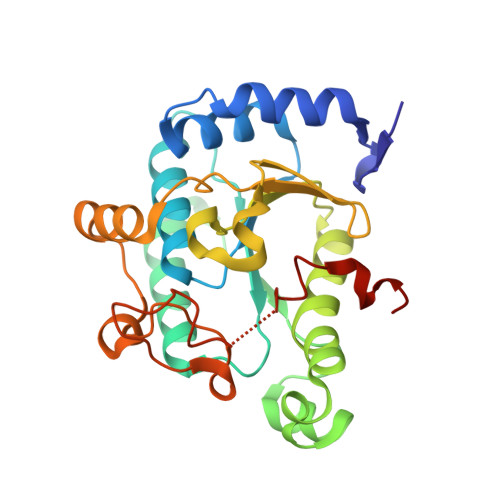Crystal structure of Saccharomyces cerevisiae 3'-phosphoadenosine-5'-phosphosulfate reductase complexed with adenosine 3',5'-bisphosphate.
Yu, Z., Lemongello, D., Segel, I.H., Fisher, A.J.(2008) Biochemistry 47: 12777-12786
- PubMed: 18991405
- DOI: https://doi.org/10.1021/bi801118f
- Primary Citation of Related Structures:
2OQ2 - PubMed Abstract:
Most assimilatory bacteria, fungi, and plants species reduce sulfate (in the activated form of APS or PAPS) to produce reduced sulfur. In yeast, PAPS reductase reduces PAPS to sulfite and PAP. Despite the difference in substrate specificity and catalytic cofactor, PAPS reductase is homologous to APS reductase in both sequence and structure, and they are suggested to share the same catalytic mechanism. Metazoans do not possess the sulfate reduction pathway, which makes APS/PAPS reductases potential drug targets for human pathogens. Here, we present the 2.05 A resolution crystal structure of the yeast PAPS reductase binary complex with product PAP bound. The N-terminal region mediates dimeric interactions resulting in a unique homodimer assembly not seen in previous APS/PAPS reductase structures. The "pyrophosphate-binding" sequence (47)TTAFGLTG(54) defines the substrate 3'-phosphate binding pocket. In yeast, Gly54 replaces a conserved aspartate found in APS reductases vacating space and charge to accommodate the 3'-phosphate of PAPS, thus regulating substrate specificity. Also, for the first time, the complete C-terminal catalytic motif (244)ECGIH(248) is revealed in the active site. The catalytic residue Cys245 is ideally positioned for an in-line attack on the beta-sulfate of PAPS. In addition, the side chain of His248 is only 4.2 A from the Sgamma of Cys245 and may serve as a catalytic base to deprotonate the active site cysteine. A hydrophobic sequence (252)RFAQFL(257) at the end of the C-terminus may provide anchoring interactions preventing the tail from swinging away from the active site as seen in other APS/PAPS reductases.
- Departments of Chemistry and Molecular and Cellular Biology, University of California, Davis, One Shields Avenue, Davis, California 95616.
Organizational Affiliation:

















